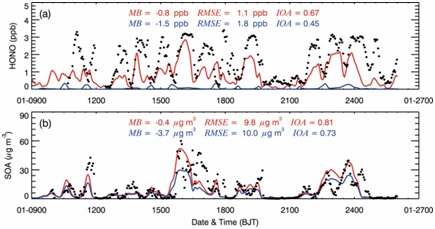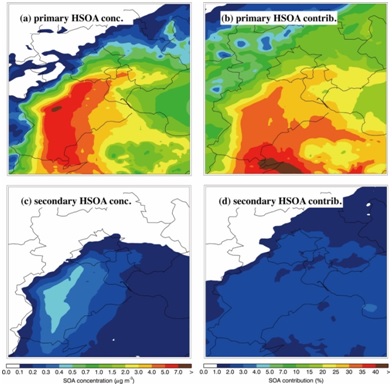
Severe air pollution happens a lot over the Beijing-Tianjin-Hebei (BTH) region in recent years. Organic aerosols (OA) are one of the most important components of fine particulate matters (PM2.5), constituting 20%-90% of PM2.5 mass in the northern hemisphere.
During haze days in winter, O3 concentrations are relatively low in BTH region, revealing the limited atmospheric oxidation capacity. OH (formed from O3 photolysis) reacting with volatile organic compounds (VOCs) is thought to be the major formation pathway of secondary organic aerosols (SOA) traditionally. Low O3 concentration during haze days do not favor SOA formation. However, SOA contribute 44%-71% of OA mass during haze days, indicating that there may be other factors enhancing SOA formation during haze days.
A research group led by Prof. LI Guohui from the Institute of Earth Environment (IEE), Chinese Academy of Sciences, used the WRF-Chem model to simulate SOA formation during a severe haze pollution episode in January 2014. The model results showed that heterogeneous HONO formation greatly enhanced SOA concentration by 46.3% over BTH region.
Fig.1 showed that including heterogeneous HONO sources in the model increased the simulated HONO concentration in Beijing by 0.7 ppb, with better agreement with the observation. The simulated SOA concentration considering heterogeneous HONO formation was increased by 3.3 μg·m-3, which only underestimated 0.4 μg·m-3 of SOA mass compared with the measurement.
Further analysis showed that the irreversible uptake of glyoxal and methylglyoxal (HSOA) contributed 8.5% to total OA mass under non-haze conditions and 30.2% under haze conditions, revealing another important pathway for SOA formation during haze days.
Glyoxal and methylglyoxal in the atmosphere come from the primary emissions from residential sources and the oxidations of VOCs. Fig.2 showed that the primary emissions of glyoxal and methylglyoxal from residential sources dominated HSOA formation, contributing 25.5% of OA mass over BTH region, while the secondary HSOA formed from the oxidation of VOCs only contributed 2.1% of OA mass over BTH region.
This study, published in Atmospheric Chemistry and Physics, highlights the great contributions of heterogeneous HONO sources and the primary emissions of glyoxal and methylglyoxal from residential sources to SOA formation during haze days in BTH.

Fig.1 Comparisons of observed (black dots) and simulated (solid red and blue lines represent considering and not considering heterogeneous HONO sources, respectively) diurnal profiles of near-surface hourly mass concentrations of (a) HONO and (b) SOA at the Institute of Remote Sensing and Digital Earth site in Beijing from 9 to 26 January 2014. (Image by XING Li et. al)

Fig.2 Spatial distribution of (a) average primary HSOA concentrations and (b) its contribution to the total SOA, and (c) average secondary HSOA concentrations and (d) its contribution to the total SOA during the simulation period. (Image by XING Li et. al)

86-10-68597521 (day)
86-10-68597289 (night)

52 Sanlihe Rd., Xicheng District,
Beijing, China (100864)

